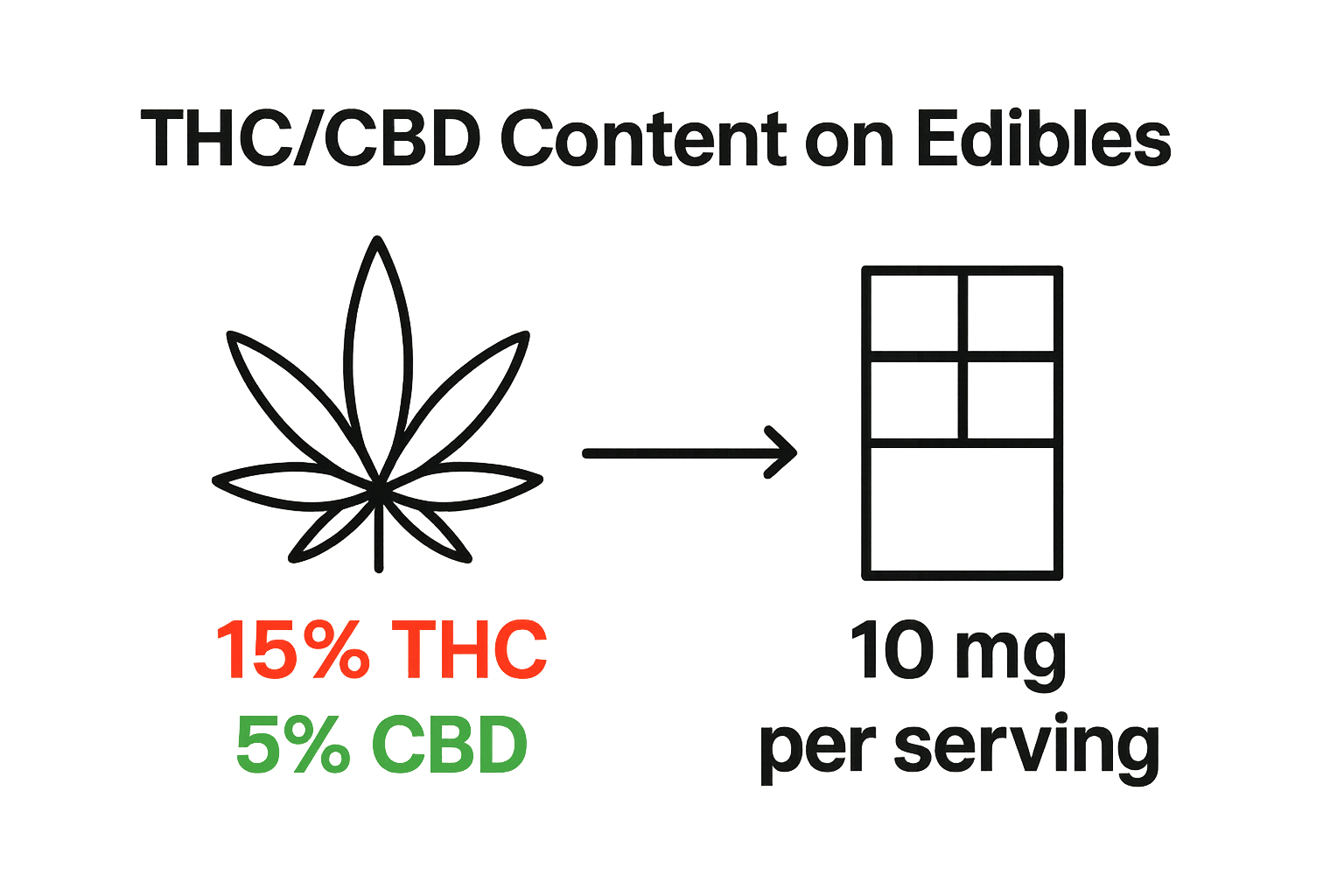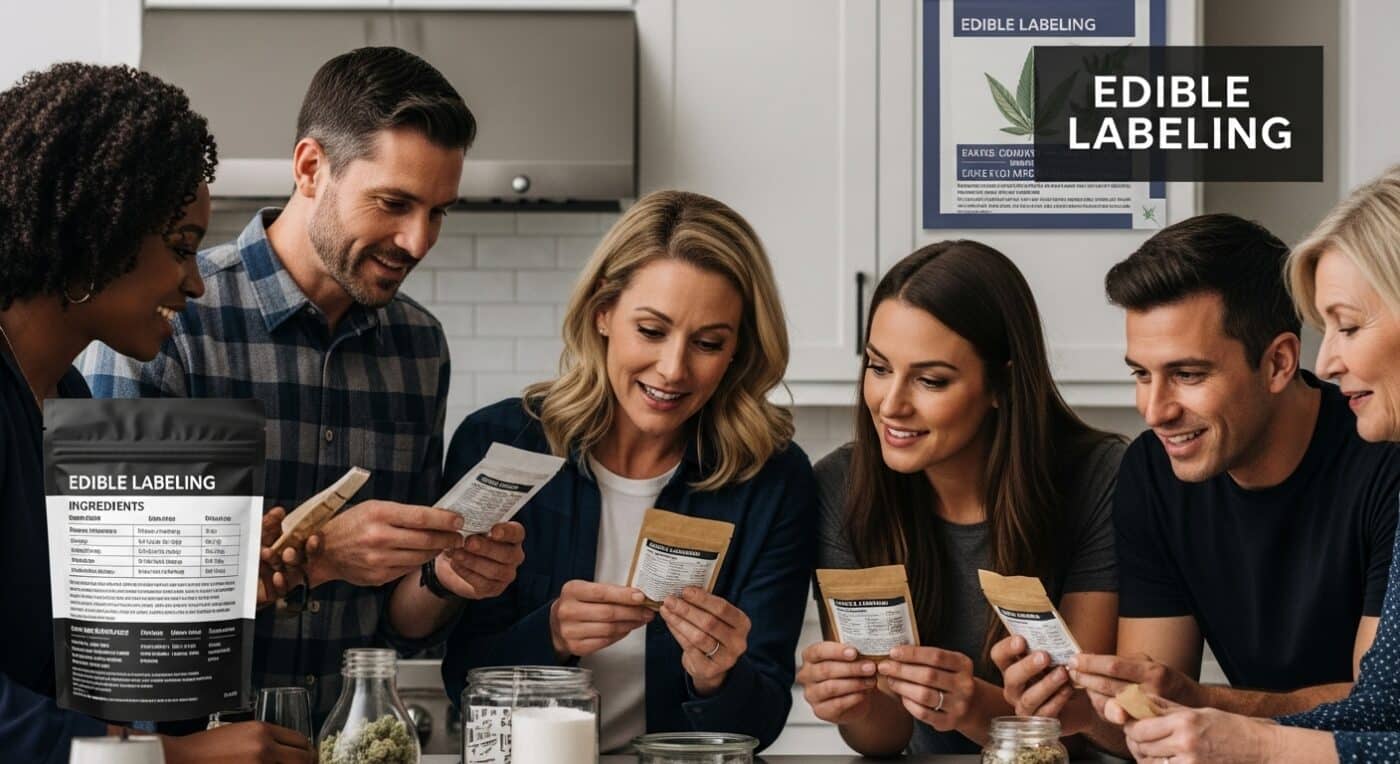Blog
Understanding Cannabis Edible Labeling for Consumers
Cannabis edibles might look just like regular gummies or brownies, but what’s printed on their packaging can be a literal lifesaver. Research shows that clear cannabis edible labels help prevent accidental consumption, especially in homes with children. That sounds reassuring and simple, right? Not quite. Because deciphering what those labels actually mean turns out to be trickier than most people expect.
Table of Contents
- What Is Cannabis Edible Labeling?
- Why Cannabis Edible Labeling Matters
- Regulations And Standards For Labeling
- Interpreting Labels For Informed Choices
Quick Summary
| Takeaway | Explanation |
|---|---|
| Labels ensure informed consumption | Cannabis edible labels provide crucial information about THC/CBD content to help consumers make safe choices. |
| Safety mechanisms are critical | Labels prevent accidental ingestion, especially among children, by distinguishing cannabis products from regular foods. |
| Clear dosage guidelines are essential | Recommended serving sizes and concentrations help users manage their consumption effectively and avoid overuse. |
| Regulatory compliance enhances trust | Adhering to labeling standards ensures product transparency and consumer safety, fostering trust in the cannabis industry. |
| Packaging must prioritize safety | Child-resistant and unattractive packaging are necessary to minimize risks associated with cannabis edibles, especially for minors. |
What is Cannabis Edible Labeling?
Cannabis edible labeling represents a critical communication tool that provides consumers with essential information about cannabis-infused products. These labels serve as comprehensive guides that offer transparency about the product’s composition, potency, ingredients, and potential effects.
Purpose of Cannabis Edible Labels
Labeling for cannabis edibles goes far beyond simple product identification. The FDA emphasizes that these labels play a crucial role in consumer safety and informed consumption. Key purposes include:
- Clearly communicating the precise amount of THC or CBD per serving
- Detailing potential allergens and ingredients
- Providing dosage recommendations
- Highlighting potential health warnings
- Ensuring regulatory compliance
Key Components of Cannabis Edible Labels
A comprehensive cannabis edible label typically includes several critical elements that help consumers make informed decisions. Mandatory information often encompasses:
- Total cannabinoid content (THC/CBD percentages)
- Net weight of the product
- Serving size and recommended dosage
- Batch or lot number for product traceability
- Extraction method and cannabis strain information
- Manufacturer contact details and production date
Understanding these labels empowers consumers to select products that align with their wellness goals, tolerance levels, and desired experiences. By providing clear, transparent information, cannabis edible labels transform complex products into accessible, user-friendly options for both medical and recreational consumers.
The following table breaks down the key components typically found on cannabis edible labels to help consumers understand what each element represents.
| Label Component | Description |
|---|---|
| Universal Cannabis Symbol | Visual icon alerting consumers the product contains cannabis |
| THC/CBD Percentages | Shows total active cannabinoids per product or serving |
| Net Weight/Volume | Indicates total amount of edible by weight (grams) or volume (ml/oz) |
| Serving Size Recommendation | Advises appropriate single portion for individual consumption |
| Ingredient List | Complete rundown of ingredients in descending order of quantity |
| Allergen Declarations | Highlights common allergens (e.g., nuts, soy, dairy) that may be present |
| Manufacturer & License Info | Lists producer contact details, license number, production and packaging date for transparency |
Why Cannabis Edible Labeling Matters
Cannabis edible labeling transcends mere regulatory compliance and emerges as a critical safety mechanism protecting consumers, preventing accidental consumption, and promoting responsible use. These labels serve as comprehensive communication tools that bridge crucial information gaps in cannabis product consumption.
Safety and Consumer Protection
Research from public health studies highlights significant risks associated with cannabis edibles, particularly concerning accidental ingestion. Precise labeling becomes a fundamental defense mechanism against unintended consumption, especially in households with children. Key safety considerations include:
- Clearly distinguishing cannabis products from regular food items
- Preventing attractive packaging that might appeal to children
- Providing explicit warnings about potential health impacts
- Indicating appropriate age restrictions
- Detailing potential allergen information
Informed Consumption and Dosage Management
Cannabis edible labels play a pivotal role in helping consumers understand product potency and appropriate consumption levels. Comprehensive labeling enables users to:
- Understand exact THC/CBD concentrations
- Manage personal tolerance levels
- Prevent potential overconsumption
- Make informed decisions about product selection
- Track potential health and wellness impacts
By transforming complex product information into clear, accessible language, cannabis edible labeling empowers consumers to make responsible choices. These labels serve not just as regulatory requirements but as essential tools for consumer education, safety, and informed decision making in an increasingly complex cannabis marketplace.
Key Components of Cannabis Edible Labels
Cannabis edible labels represent a complex system of information designed to provide consumers with comprehensive insights into product composition, safety, and consumption guidelines. These labels function as critical communication tools that bridge regulatory requirements and consumer understanding.
Primary Identification Elements
California Department of Cannabis Control guidelines mandate specific primary identification components that ensure clarity and consumer protection. Essential identification details include:
- Distinctive universal cannabis product symbol
- Clear product identity
- Net weight or product volume
- Processor’s business name and license number
- Unique product identification number
- Manufacturing or packaging date
Comprehensive Product Information
Beyond basic identification, cannabis edible labels must provide detailed product specifications that enable informed consumption. Critical information sections encompass:
- Total cannabinoid content (THC/CBD percentages)
- Precise serving size recommendations
- Number of servings per container
- Complete ingredient list in descending order
- Potential allergen declarations
- Extraction method details
- Recommended storage conditions
These multifaceted labels transform complex cannabis products into transparent, accessible options. By providing exhaustive information, manufacturers empower consumers to make educated decisions about product selection, consumption, and potential health implications. The intricate labeling process ensures safety, regulatory compliance, and consumer confidence in an evolving cannabis marketplace.
Regulations and Standards for Labeling
Cannabis edible labeling regulations represent a complex framework designed to protect consumers, ensure product transparency, and maintain industry standards. These comprehensive guidelines emerge from collaborative efforts between state regulatory bodies, public health organizations, and cannabis industry stakeholders.
Packaging and Visibility Requirements
California Department of Cannabis Control regulations establish stringent packaging standards that prioritize consumer safety and product integrity. Critical packaging requirements include:
- Child-resistant packaging design
- Tamper-evident seals
- Resealable containers
- Prominent universal cannabis product symbol
- Clear separation from traditional food packaging
- Non-attractive designs preventing youth appeal
Mandatory Label Information
Regulatory standards mandate extensive information disclosure to empower consumer decision-making. Essential labeling components encompass:
- Total cannabinoid content (THC/CBD percentages)
- Precise serving size recommendations
- Activation time for edible effects
- Comprehensive ingredient list
- Potential allergen declarations
- Health and safety warnings
- Processor identification and license number
These multifaceted regulations transform cannabis edible labeling from a simple identification mechanism into a sophisticated consumer protection tool. By establishing clear, comprehensive guidelines, regulatory bodies ensure that consumers receive accurate, transparent information about product composition, potential effects, and safe consumption practices.
This table compares regulatory packaging and labeling requirements for cannabis edibles, clarifying their purpose in consumer safety and transparency.
| Regulatory Feature | Purpose |
|---|---|
| Child-resistant Packaging | Prevents accidental access by children |
| Tamper-evident Seals | Indicates if product has been opened or altered |
| Non-attractive Design | Reduces risk of appealing to youth or mimicking regular food |
| Universal Cannabis Symbol | Alerts all ages/abilities to cannabis presence |
| Mandatory Health Warnings | Informs of risks, age restrictions, and non-suitability for children |
| Batch/Production Number | Ensures traceability for recalls or quality assurance |
Interpreting Labels for Informed Choices
Navigating cannabis edible labels requires a strategic approach that blends careful reading, understanding of technical information, and personal wellness considerations. Consumers must develop skills to decode complex label information and translate it into meaningful personal consumption guidance.
Understanding Cannabinoid Content
Research from the University of Waterloo highlights significant challenges consumers face when interpreting numerical THC representations. Key strategies for understanding cannabinoid content include:

- Recognizing total THC and CBD percentages
- Comparing milligram amounts per serving
- Identifying concentration levels relative to personal tolerance
- Understanding activation time for different cannabinoid profiles
- Distinguishing between indica, sativa, and hybrid cannabinoid effects
Assessing Personal Consumption Parameters
Interpreting cannabis edible labels demands a personalized approach that considers individual physiological responses and wellness objectives. Critical evaluation factors encompass:
- Personal tolerance levels
- Intended therapeutic or recreational outcomes
- Potential interactions with existing medications
- Previous cannabis consumption experience
- Desired duration and intensity of effects
By developing a nuanced understanding of label information, consumers transform complex numerical data into actionable insights. This approach empowers individuals to make informed decisions that prioritize safety, optimize personal experience, and align with individual wellness goals.

Experience True Transparency With Good Tide CBD Gummies
Do you ever feel lost or unsure while reading cannabis edible labels, worried about what exactly is inside and how it might affect you? Many consumers struggle to decode complex label information, especially when it comes to THC and CBD content, ingredient lists, and third-party lab results. At Good Tide, we understand how important clear labeling and trustworthy details are for your wellness and relaxation journey. We make it easy to access the facts, not just the flavors.

Every Good Tide CBD Gummies product shines with real, easy-to-understand information. You get solventless hash rosin extraction, delicious tropical flavors, and complete third-party lab testing results before you buy. Feel confident with detailed breakdowns on effects and ingredients, backed by a community of real reviews. Ready to take control of your cannabis experience and shop edibles with confidence? Visit https://goodtidecbdgummies.com to explore our premium selection and see the difference that transparency makes. Trust what you read. Savor what you taste. Shop now while fresh batches are available.
Frequently Asked Questions
What information is found on cannabis edible labels?
Cannabis edible labels typically include important details such as total cannabinoid content (THC/CBD percentages), serving size recommendations, a complete ingredient list, allergen warnings, and the manufacturer’s contact information.
How can I interpret the THC and CBD content on cannabis edible labels?
To interpret THC and CBD content, look for the total percentages as well as the milligram amount per serving. This information helps you understand the potency of the product and how it may affect you based on your personal tolerance.
Why is dosage management crucial when consuming cannabis edibles?
Dosage management is essential because it allows consumers to prevent overconsumption, manage their personal tolerance levels, and make informed decisions on product selection to achieve desired effects responsibly.
What safety measures do cannabis edible labels usually include?
Cannabis edible labels often include safety measures such as age restrictions, health and safety warnings, allergen information, and indications that the product is not suitable for children. These components help prevent accidental consumption and ensure consumer safety.
Recommended
- Understanding Why Choose Hash Rosin for Cannabis Consumption – GOOD TIDE CBD GUMMIES
- Understanding Cannabis Edible Terminology Explained – GOOD TIDE CBD GUMMIES
- What is Rosin Pressing? Understanding Solventless Cannabis Extracts – GOOD TIDE CBD GUMMIES
- Ultimate Cannabis Edibles Usage Guide for 2025 – GOOD TIDE CBD GUMMIES

